Adding dimension to short brown hair transforms your look from flat to fabulous in an instant.
Lowlights create depth, richness, and movement that catches the light beautifully, making your brunette locks appear thicker and more vibrant.
Whether you’re looking for subtle enhancements or bold contrasts, the right lowlight technique can completely refresh your style without the commitment of a full color change.
This comprehensive guide explores over 27 trendy lowlights for short brown hair on brunettes, covering everything from classic chocolate tones to modern shadow techniques.
You’ll discover the best color combinations for different skin tones, learn about maintenance requirements, and find styling tips that maximize the impact of your new dimension.
Each technique is designed specifically for short hair, ensuring your lowlights complement your cut rather than compete with it. From face-framing pieces to all-over color melts, these options provide endless possibilities for customizing your brunette shade.
Contents
- 1 1. Classic Chocolate Lowlights
- 2 2. Espresso Brown Lowlights
- 3 3. Caramel and Brown Shadow Melt
- 4 4. Mahogany Lowlights for Warmth
- 5 5. Ash Brown Lowlights for Cool Tones
- 6 6. Chestnut Lowlights with Golden Undertones
- 7 7. Deep Brunette Shadow Roots
- 8 8. Mocha Lowlights for Medium Brown Hair
- 9 9. Burgundy-Tinted Brown Lowlights
- 10 10. Honey Brown Babylights and Lowlights
- 11 11. Ombré Lowlights from Root to End
- 12 12. Dimensional Ribbon Lowlights
- 13 13. Neutral Brown Lowlights for Balance
- 14 14. Face-Framing Lowlights Only
- 15 15. Tortoiseshell Lowlights Technique
- 16 16. Smoky Brown Lowlights
- 17 17. Subtle Brunette Depth Enhancement
- 18 18. Lowlights with Glossing Treatment
- 19 19. Peekaboo Lowlights Under Layers
- 20 20. Babylight Lowlight Combo for Texture
- 21 21. Cool-Toned Lowlight Correction
- 22 22. Root Smudge with Lowlights
- 23 23. Dimensional Lowlights for Fine Hair
- 24 24. Seasonal Transition Lowlights
- 25 25. Balayage-Style Lowlights
- 26 26. Contour Lowlights for Face Shape
- 27 27. Multi-Tonal Lowlight Blend
- 28 Maintenance Tips for Lowlights on Short Brown Hair
- 29 Choosing the Right Lowlight Shade
- 30 Professional vs. At-Home Lowlights
- 31 Styling Tips to Showcase Your Lowlights
- 32 Common Lowlight Mistakes to Avoid
- 33 Lowlights for Different Short Haircut Styles
- 34 Cost Considerations for Lowlights
- 35 Lowlights for Different Age Groups
- 36 Combining Lowlights with Other Color Techniques
- 37 Seasonal Care for Lowlighted Hair
- 38 Troubleshooting Common Lowlight Issues
- 39 Consultation Tips for Best Results
- 40 Hair Health Considerations
- 41 Environmental and Lifestyle Factors
- 42 Future Color Planning
- 43 Conclusion
1. Classic Chocolate Lowlights

Classic chocolate lowlights remain the most popular choice for brunettes seeking subtle dimension.
These rich, warm tones sit just a few shades deeper than your natural brown base, creating shadows that mimic how sunlight naturally plays through hair.
- The chocolate shade works universally across all brunette bases from light to dark brown.
- This technique adds instant depth without appearing harsh or striped, making it ideal for first-time color users.
- Stylists typically place these lowlights underneath the top layer, creating a peek-a-boo effect when hair moves.
- The color dimension makes short haircuts like bobs and lobs appear fuller and more textured.
- Maintenance is minimal since the color closely matches your natural base, allowing seamless grow-out.
- Chocolate lowlights complement warm skin tones particularly well, enhancing golden and olive undertones.
- The technique requires processing time of 20-30 minutes depending on desired intensity.
- These lowlights photograph beautifully, adding definition that shows up clearly in pictures.
2. Espresso Brown Lowlights

Espresso brown lowlights deliver dramatic depth for those wanting bolder contrast. This dark, cool-toned brown approaches black without crossing into that territory, providing striking dimension against medium to light brown bases.
- The espresso shade creates a sophisticated, high-contrast look perfect for modern short hairstyles.
- These lowlights work exceptionally well with asymmetrical cuts and sharp angles, emphasizing geometric shapes.
- The cool undertones in espresso brown complement cool skin tones and can neutralize unwanted warmth.
- Placement typically focuses on the underneath sections and around the face for maximum impact.
- This color choice makes thin or fine hair appear significantly thicker due to the shadow effect.
- Espresso lowlights require more maintenance than lighter options since grow-out becomes more visible.
- The dramatic contrast works beautifully for edgy, fashion-forward looks and statement hairstyles.
- Color-safe shampoo and regular conditioning treatments keep the deep brown shade from fading to red.
3. Caramel and Brown Shadow Melt
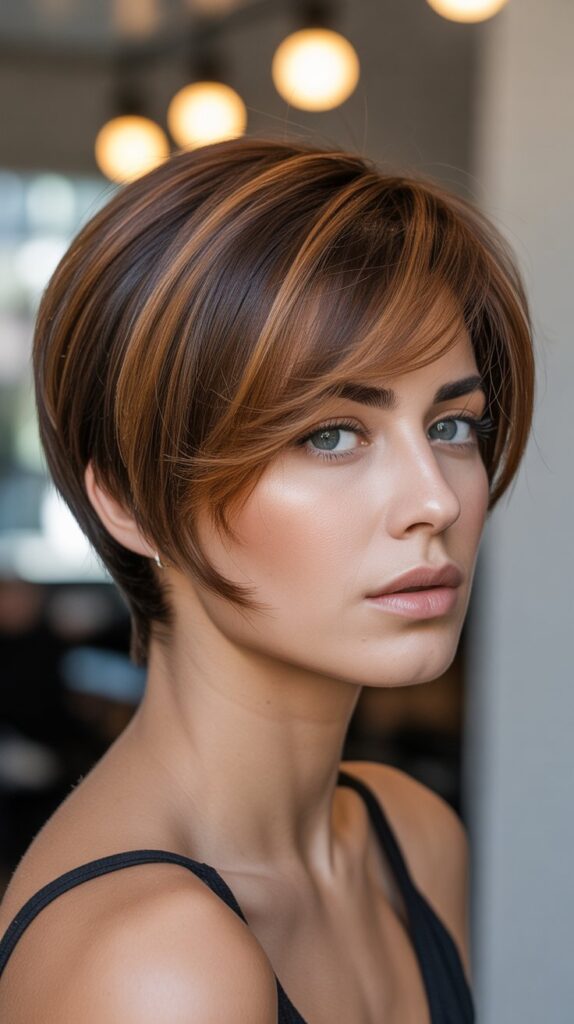
The caramel and brown shadow melt combines highlights and lowlights for ultimate dimension.
This technique creates a seamless transition between lighter caramel tones and deeper brown shadows, resulting in multidimensional color that moves naturally.
- The melting technique eliminates harsh lines, creating a gradual flow between all color tones.
- This approach works perfectly for short hair since the color transition happens in a compact space.
- Caramel highlights brighten the face while brown shadows add depth throughout the style.
- The combination suits all skin tones by balancing warm and cool undertones simultaneously.
- Stylists use a balayage or hand-painting method to achieve the natural blended effect.
- This color service typically takes 2-3 hours due to the multiple color applications required.
- The shadow melt grows out more gracefully than traditional foil highlights, reducing salon visits.
- Regular toning every 6-8 weeks keeps the caramel from turning brassy and maintains color harmony.
4. Mahogany Lowlights for Warmth

Mahogany lowlights infuse warmth into brown hair with subtle red undertones. This reddish-brown shade adds vibrancy and life to flat brown hair, creating a luxurious, jewel-toned effect perfect for fall and winter.
- The red undertones in mahogany create warmth without appearing obviously red or unnatural.
- These lowlights work best on medium to dark brown bases where the red depth shows through beautifully.
- Mahogany particularly flatters warm and neutral skin tones, adding a healthy glow to the complexion.
- The color placement should focus on mid-lengths and ends to avoid an overly warm root area.
- This shade requires color-depositing conditioners to maintain vibrancy between salon appointments.
- Mahogany lowlights fade more quickly than neutral browns due to the red pigment molecules being larger.
- The warmth from these lowlights makes eyes appear brighter and more defined.
- Combining mahogany with neutral brown lowlights creates even more dimension and complexity.
5. Ash Brown Lowlights for Cool Tones
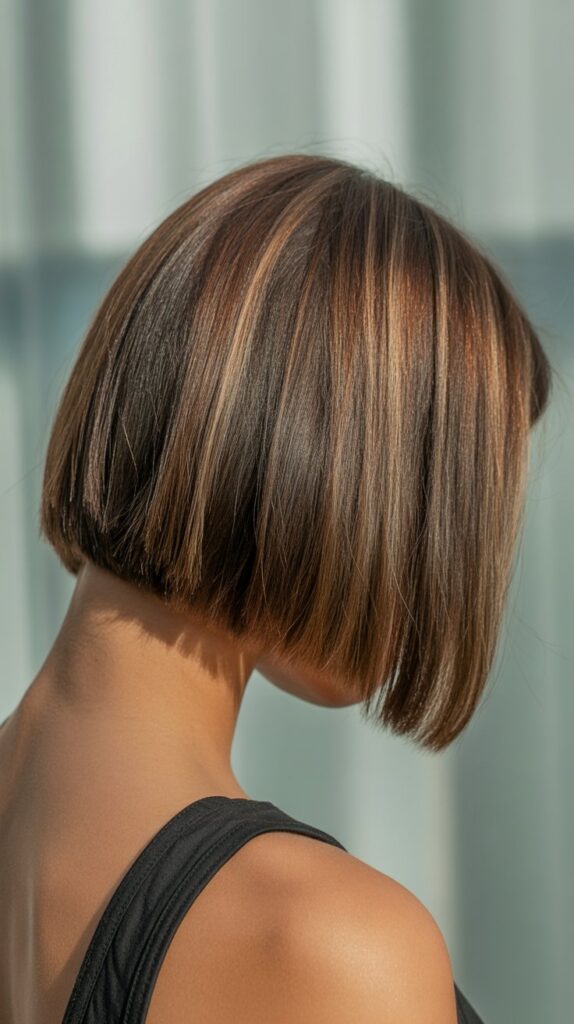
Ash brown lowlights provide cool-toned depth perfect for neutralizing unwanted warmth. These gray-toned browns create sophisticated, modern dimension while keeping the overall look cool and fresh.
- Ash brown works exceptionally well for those with cool or pink undertones in their skin.
- The gray tones neutralize brassy or orange hues that naturally occur in brown hair.
- These lowlights create a more muted, subtle dimension compared to warm-toned alternatives.
- Placement throughout the hair creates an all-over cooling effect on previously warm brown hair.
- Ash tones require purple-toned shampoos and conditioners to maintain the cool color and prevent fading.
- The color can appear almost silvery in bright light, adding unique interest to short styles.
- This option suits professional environments where subtle, sophisticated color is preferred.
- Ash brown lowlights pair beautifully with silver jewelry and cool-toned clothing colors.
6. Chestnut Lowlights with Golden Undertones
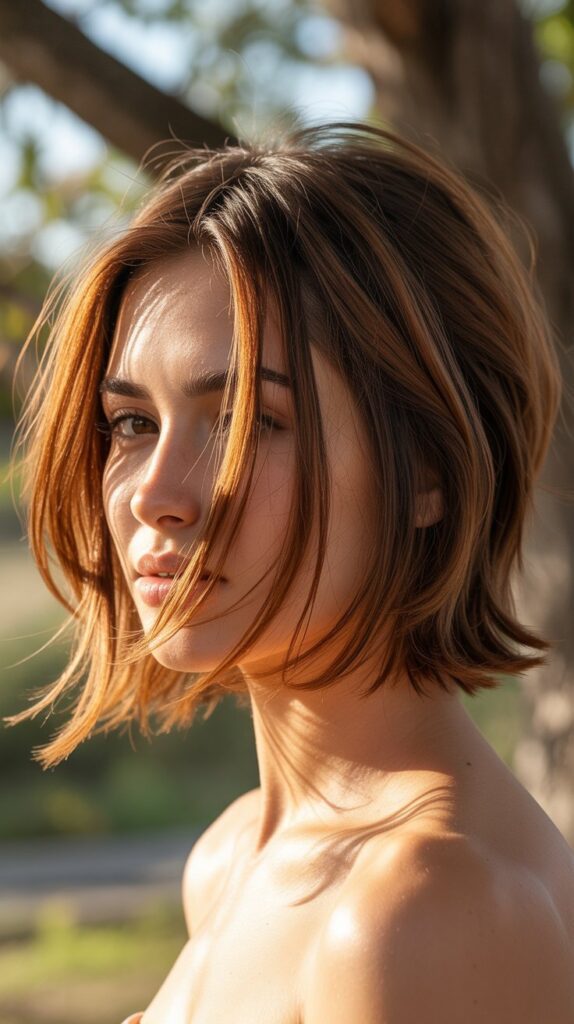
Chestnut lowlights with golden undertones create sun-kissed warmth perfect for brightening brown hair.
This nutty brown shade sits between cool and warm, offering versatility that works across many skin tones and brown bases.
- The golden undertones catch natural and artificial light beautifully, adding luminosity to short hair.
- Chestnut works universally on light, medium, and dark brown hair with equally flattering results.
- The warmth level remains subtle enough for professional settings while still providing noticeable dimension.
- These lowlights require less maintenance than purely warm tones since the golden undertones fade gracefully.
- Face-framing placement brightens the complexion and draws attention to facial features.
- The color mimics natural sun-lightening, creating an authentic, lived-in appearance.
- Chestnut lowlights work year-round, transitioning seamlessly between seasons and trending color palettes.
- Combining chestnut lowlights with caramel highlights creates maximum dimension for short haircuts.
7. Deep Brunette Shadow Roots
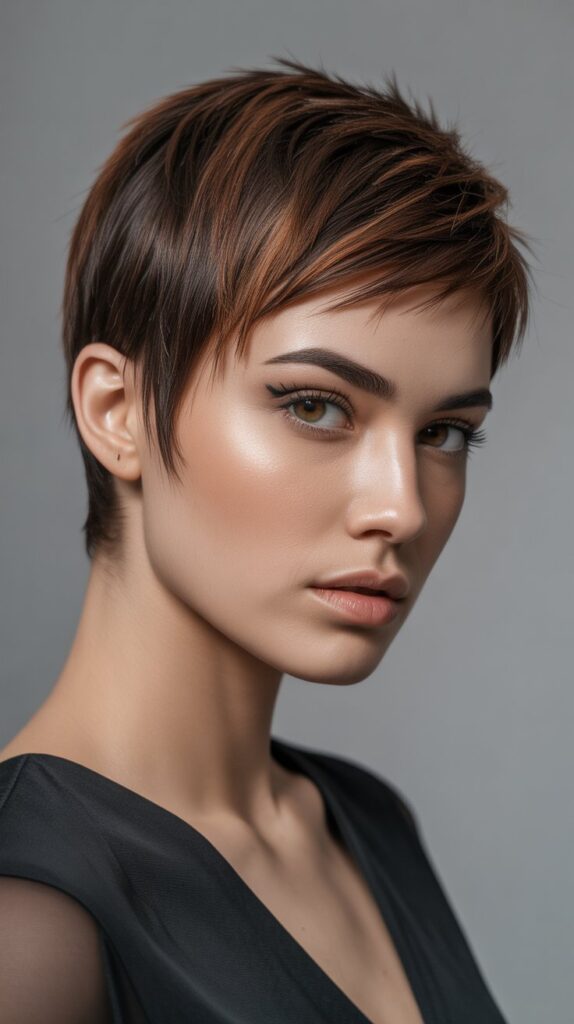
Deep brunette shadow roots create intentional darkness at the scalp that gradually transitions to lighter brown. This low-maintenance technique provides built-in dimension while minimizing frequent touch-ups.
- The shadow root technique extends time between salon visits significantly, sometimes up to 12 weeks.
- Darker roots add instant depth and make the overall color appear more multidimensional.
- This approach works particularly well for short hair since the transition happens quickly from root to end.
- The technique suits all brown shades from light to dark, simply adjusting the darkness level at roots.
- Shadow roots create a natural, effortless look that appears intentionally styled rather than grown out.
- The darker base makes hair appear thicker at the root area where many people experience finer hair.
- Application typically takes less time than traditional all-over color since focus remains at the root zone.
- This method works beautifully for those transitioning away from previous highlighting or color treatments.
8. Mocha Lowlights for Medium Brown Hair
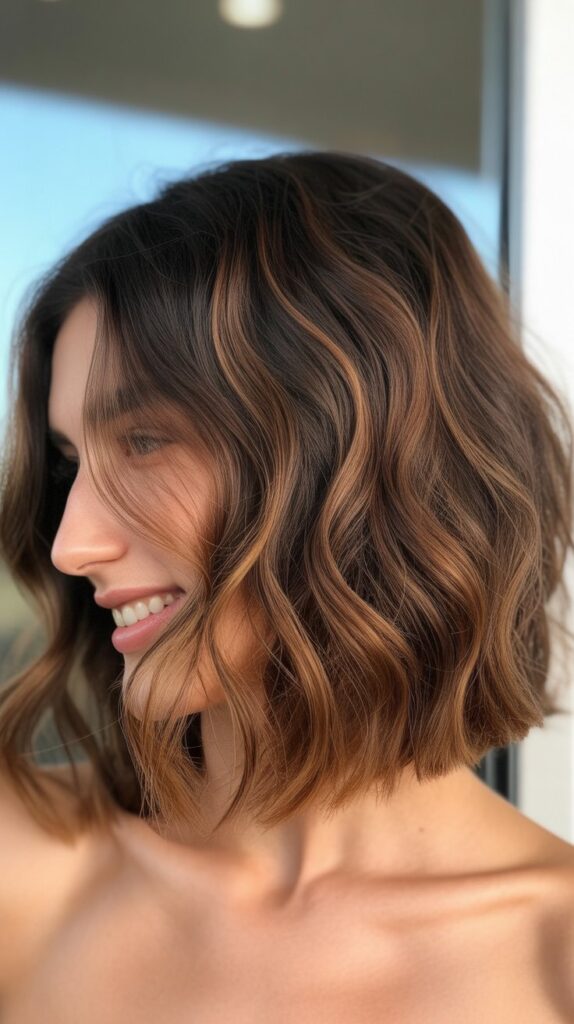
Mocha lowlights offer the perfect balance between chocolate and espresso for medium brown hair. This coffee-inspired shade creates subtle depth that enhances natural brown without dramatic contrast.
- The mocha tone contains both warm and cool undertones, making it universally flattering across skin tones.
- These lowlights work best when placed strategically throughout medium brown hair for all-over dimension.
- The color closely mimics natural shadow in brown hair, creating an authentically enhanced appearance.
- Mocha requires minimal maintenance since it stays within one to two shades of most medium brown bases.
- The subtle contrast makes this option ideal for conservative workplaces or first-time color users.
- Color longevity extends longer than dramatic contrasts since fading remains less noticeable.
- Mocha lowlights complement both warm and cool jewelry tones, offering styling versatility.
- The shade photographs consistently well across different lighting conditions and camera types.
9. Burgundy-Tinted Brown Lowlights
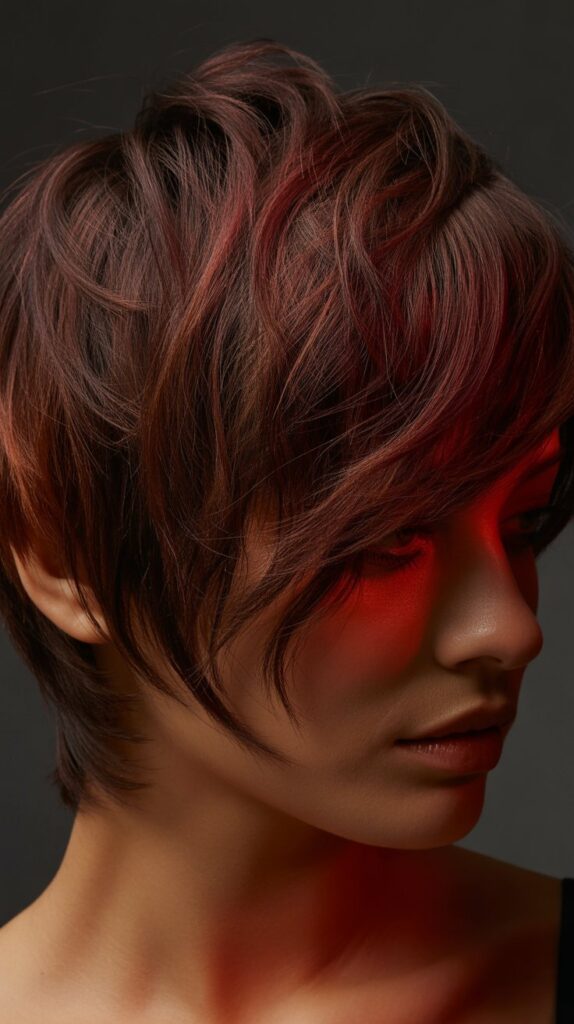
Burgundy-tinted brown lowlights add unexpected richness with subtle wine-colored undertones. This sophisticated option provides depth while introducing jewel-toned dimension perfect for making a statement.
- The burgundy tint appears most visible in direct sunlight, revealing hidden dimension in indoor lighting.
- These lowlights work best on medium to dark brown bases where the wine tones show through clearly.
- The color choice flatters warm and neutral skin tones while adding an artistic edge to short styles.
- Application focuses on underneath sections and interior layers for peek-a-boo color reveals.
- Burgundy-tinted lowlights require color-safe products and regular gloss treatments to maintain vibrancy.
- The unique color combination sets this option apart from standard brown lowlight choices.
- This technique works beautifully for creative professionals or those in artistic industries.
- Pairing burgundy-tinted lowlights with neutral brown creates a sophisticated, multifaceted color palette.
10. Honey Brown Babylights and Lowlights
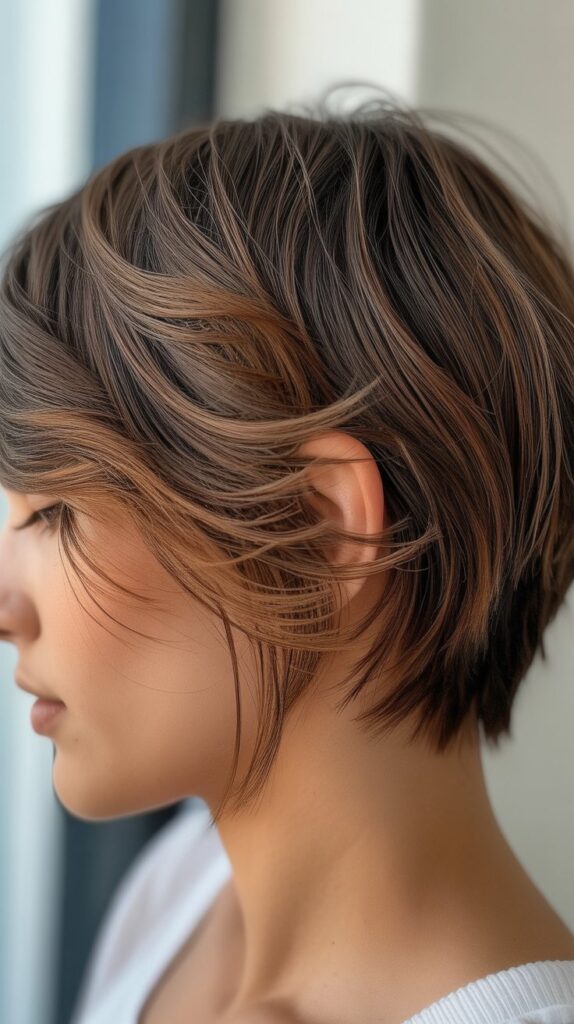
Honey brown babylights combined with lowlights create ultra-fine dimension throughout short hair.
This delicate technique uses very thin sections for both highlights and lowlights, mimicking how children’s hair naturally lightens.
- Babylights require exceptional precision, making them perfect for short hair where each strand shows clearly.
- The combination of light and dark creates maximum dimension in minimal hair length.
- Honey brown adds warmth without appearing brassy or overly golden on brown bases.
- This technique takes longer to apply due to the small section sizes but delivers unmatched natural results.
- The fine weaving creates movement and texture even in the straightest, finest hair types.
- Maintenance intervals extend longer since the delicate placement grows out seamlessly without harsh lines.
- The subtle dimension suits all ages from teenagers to mature clients seeking natural enhancement.
- Honey brown babylights work particularly well around the face to brighten and frame features.
11. Ombré Lowlights from Root to End
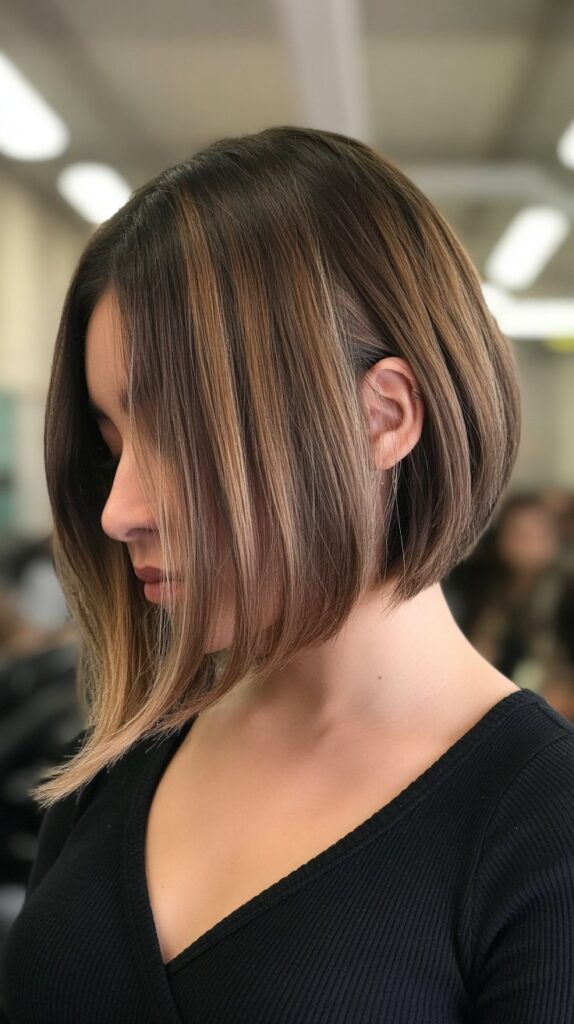
Ombré lowlights create a reverse of the traditional ombré by going darker toward the ends. This unexpected technique adds weight and dimension to the lower portions of short haircuts.
- The darker ends create visual weight, making short hair appear fuller at the bottom where many styles need volume.
- This technique works exceptionally well with bobs and lobs that benefit from added depth at the perimeter.
- Color placement gradually transitions from natural roots to progressively darker ends over several inches.
- The reverse ombré suits those wanting to appear more grounded and sophisticated in their color choices.
- Application typically uses hand-painting techniques for smooth, gradual color transitions.
- This option requires less maintenance at the roots since the natural color remains untouched.
- The darker ends protect the most fragile portion of short hair from appearing thin or wispy.
- Combining reverse ombré lowlights with traditional highlights creates stunning multidimensional results.
12. Dimensional Ribbon Lowlights

Dimensional ribbon lowlights feature thicker, more visible sections of lowlights placed strategically throughout short hair.
This bold technique creates intentional contrast similar to chunky highlights but darker.
- Ribbon lowlights make a statement, offering bolder dimension than traditional fine-weaved lowlights.
- The thicker sections suit short hair particularly well since they remain visible throughout various styling methods.
- Placement focuses on areas where natural shadows would occur, enhancing the hair’s architectural shape.
- This technique works beautifully with asymmetrical cuts, emphasizing angles and geometric lines.
- Color contrast can range from subtle to dramatic depending on the shade difference chosen.
- The bold approach suits fashion-forward individuals comfortable making definitive style statements.
- Ribbon lowlights require touch-ups every 8-10 weeks as grow-out becomes more visible than subtle techniques.
- The chunky placement creates interesting patterns when hair moves, adding dynamic visual interest.
13. Neutral Brown Lowlights for Balance
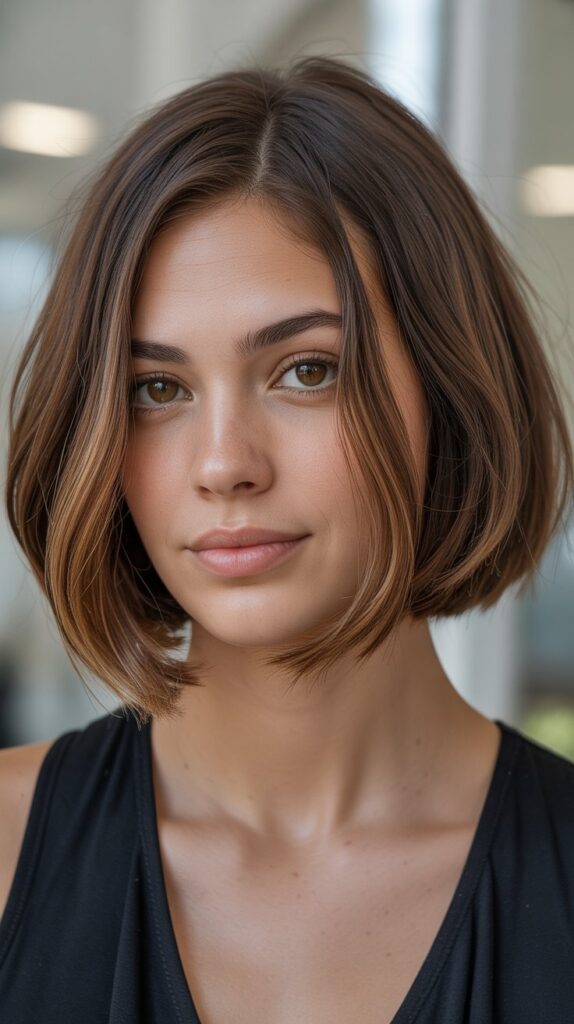
Neutral brown lowlights provide perfect balance between warm and cool undertones. This versatile shade enhances brown hair without pushing color temperature in either direction.
- Neutral browns work universally across all skin tones since they contain balanced undertones.
- The color choice ensures lowlights complement rather than clash with existing hair color.
- These lowlights provide dimension without changing the overall warmth or coolness of your brown shade.
- Application throughout the hair creates subtle, all-over depth that appears completely natural.
- Neutral brown requires the least maintenance among all lowlight options due to its versatility during fading.
- The balanced tone works in all lighting conditions from fluorescent office lights to natural outdoor settings.
- This option suits conservative professionals or those preferring understated enhancement.
- Neutral brown lowlights serve as an excellent base for adding more adventurous colors later if desired.
14. Face-Framing Lowlights Only
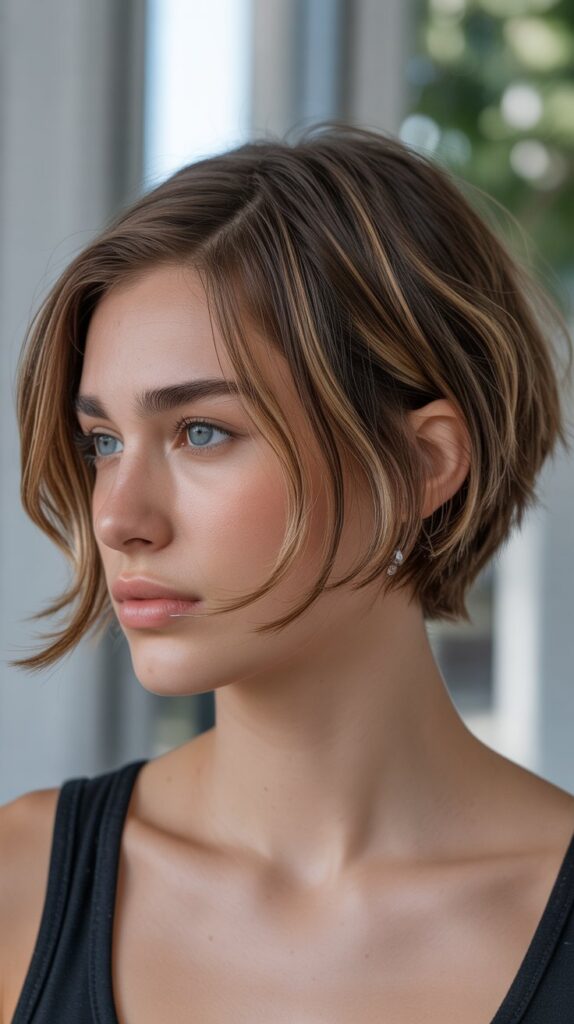
Face-framing lowlights concentrate darker color around the perimeter, creating a softening frame effect. This targeted technique adds dimension where it matters most without committing to all-over color.
- Concentrated placement around the face creates a natural contouring effect that flatters facial features.
- This minimal approach requires less time and expense compared to full-head lowlight applications.
- The darker frame draws attention inward toward eyes and facial expressions rather than outward to hair.
- Face-framing lowlights work particularly well with bangs and shorter fringe styles.
- This technique suits those wanting to test lowlights before committing to more extensive color.
- The placement creates a polished, finished look even when hair grows out significantly.
- Darker face-framing sections make the interior hair appear lighter and brighter by contrast.
- This approach works beautifully for softening harsh or angular face shapes through color placement.
15. Tortoiseshell Lowlights Technique

Tortoiseshell lowlights combine multiple brown shades inspired by the natural patterns in tortoiseshell. This sophisticated technique blends warm caramel, cool ash, and deep chocolate tones for maximum dimension.
- The varied color placement mimics natural shell patterns, creating organic, flowing dimension throughout hair.
- Multiple shade variations provide unmatched depth and complexity perfect for short hair where color shows prominently.
- This technique works beautifully across all brown bases from light to dark.
- The combination of warm and cool tones creates balance that flatters all skin undertones.
- Application requires advanced color skills, making this a premium salon service.
- The natural-looking result appears sun-kissed and effortless rather than obviously colored.
- Tortoiseshell grows out gracefully due to the varied placement and multiple color tones used.
- This trending technique has gained popularity on social media for its Instagram-worthy dimensional results.
16. Smoky Brown Lowlights
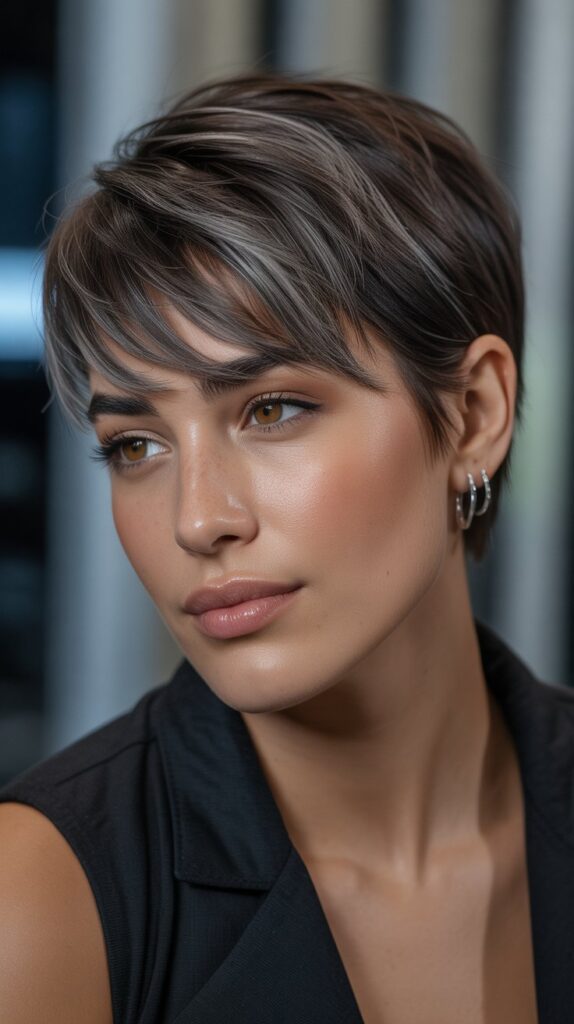
Smoky brown lowlights infuse gray tones into brown for an edgy, modern look. This cool-toned option creates mysterious depth perfect for those seeking unconventional dimension.
- The gray infusion creates an almost metallic effect in certain lighting conditions.
- Smoky tones work best on medium to dark brown bases where the gray dimension shows through clearly.
- This contemporary option suits fashion-forward individuals comfortable with trend-driven color choices.
- The cool gray undertones neutralize any warmth or brassiness in existing brown hair.
- Application focuses on creating smoke-like wisps of gray-brown throughout the style.
- These lowlights require purple-toning shampoos to maintain the gray pigments and prevent yellowing.
- The unique color combination works particularly well with edgy, asymmetrical short haircuts.
- Smoky brown lowlights create an urban, sophisticated aesthetic perfect for city dwellers.
17. Subtle Brunette Depth Enhancement

Subtle brunette depth enhancement uses lowlights just one shade darker than natural color. This conservative approach adds gentle dimension without obvious color change.
- The minimal shade difference creates shadows that appear completely natural to untrained eyes.
- This technique suits those wanting enhancement rather than transformation in their hair color.
- The subtle approach works perfectly in conservative professional environments with strict appearance policies.
- Application throughout the hair creates all-over richness without any high-contrast sections.
- Maintenance remains minimal since grow-out blends seamlessly with natural hair color.
- The gentle dimension makes hair appear healthier and more lustrous without appearing colored.
- This option serves as an excellent introduction to color for those nervous about dramatic changes.
- Subtle depth enhancement can always be intensified in future appointments if desired.
18. Lowlights with Glossing Treatment
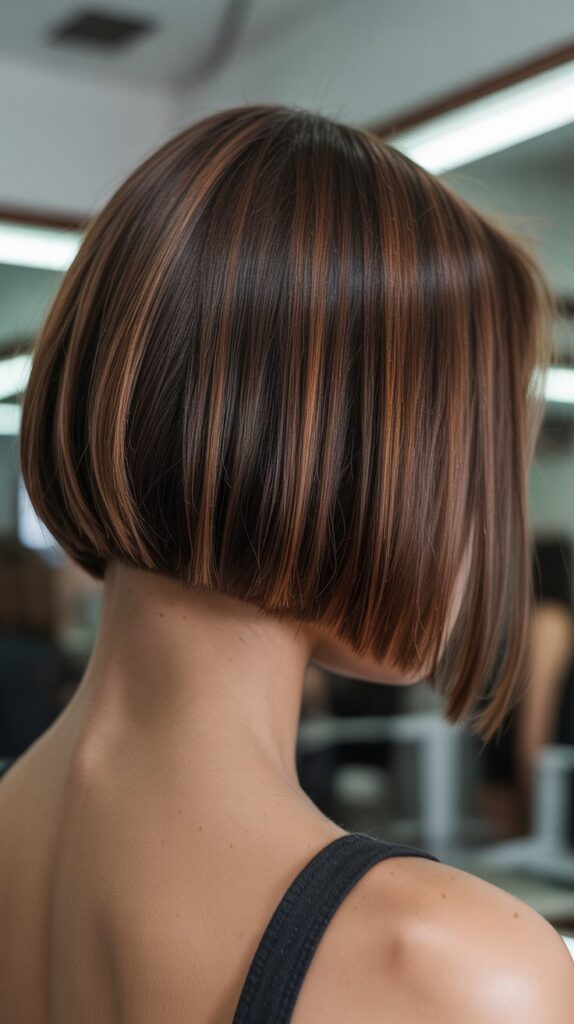
Combining lowlights with a glossing treatment creates dimensional color plus mirror-like shine. The gloss seals the lowlight color while adding exceptional luminosity to short hair.
- Glossing treatments deposit semi-permanent color that enhances lowlight dimension while adding shine.
- The combination service typically adds 20-30 minutes to lowlight processing time.
- Gloss creates a protective coating over hair, helping lowlights last longer between salon visits.
- The shine enhancement makes short hair appear healthier and more vibrant immediately.
- This paired service works particularly well for damaged or dull hair needing both color and conditioning.
- Glossing helps blend any slight color variations for a more seamless, professional finish.
- The treatment typically lasts 4-6 weeks before requiring refreshing.
- Many salons offer glossing as a standalone service between lowlight appointments to maintain vibrancy.
19. Peekaboo Lowlights Under Layers
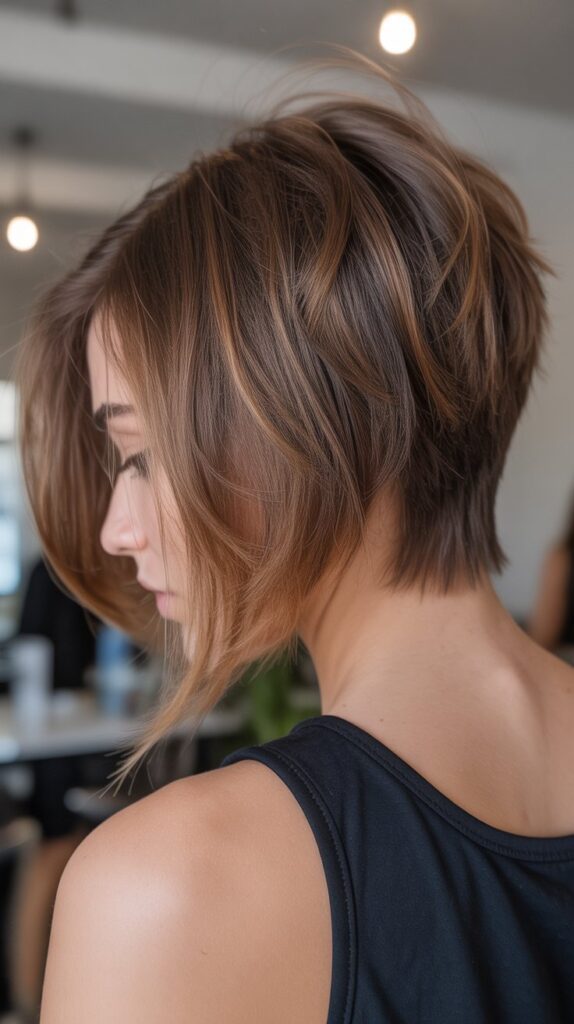
Peekaboo lowlights hide beneath top layers, revealing darker dimension only when hair moves. This playful technique adds surprise elements perfect for short, layered cuts.
- The hidden placement creates a conservative appearance for professional settings that transforms when styled differently.
- Peekaboo lowlights work best with layered cuts where underneath sections occasionally show through.
- This approach allows for bolder color choices since the lowlights remain partially hidden most of the time.
- The technique particularly suits those wanting versatility between polished and edgy looks.
- Placement focuses entirely on underneath layers and interior sections rather than surface hair.
- The surprise factor creates visual interest and conversation-starting color reveals.
- This option works well for those with strict workplace appearance requirements who want personal expression.
- Peekaboo lowlights can use more dramatic shades like deep espresso or even burgundy since they show minimally.
20. Babylight Lowlight Combo for Texture
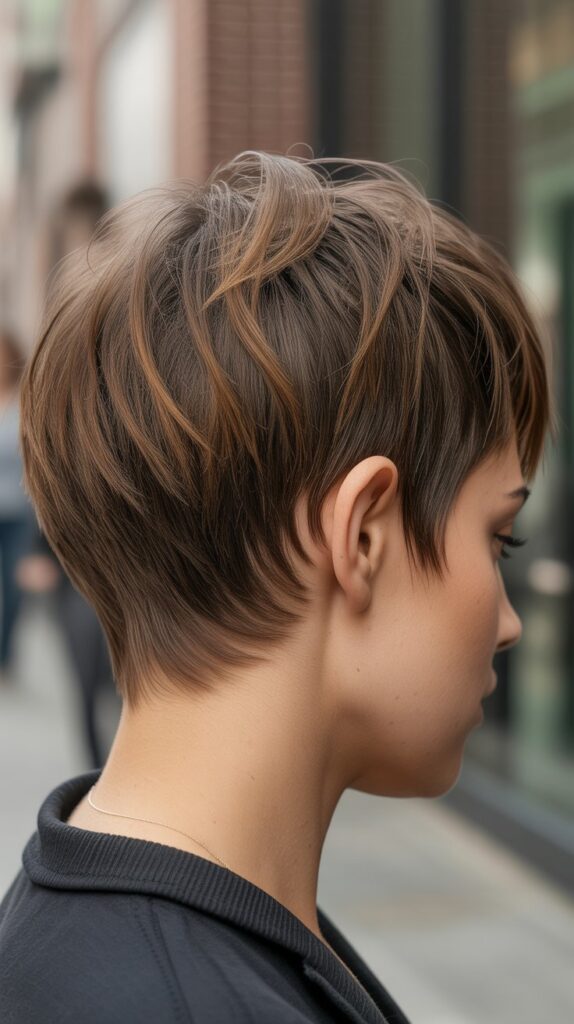
Combining babylights and lowlights creates the ultimate textured dimension for short brown hair. This comprehensive technique uses ultra-fine sections of both lighter and darker color for maximum visual interest.
- The combination creates more dimension than either technique alone could achieve.
- Fine weaving throughout makes even the flattest hair appear textured and full of movement.
- This labor-intensive technique takes 2-3 hours but delivers professional, high-end results.
- The varied lightness and darkness mimics natural sun-lightening and shadowing for authentic appearance.
- Short hair showcases this detailed work perfectly since every carefully placed strand remains visible.
- The technique suits all hair textures from straight to curly, enhancing natural texture patterns.
- Maintenance intervals extend 10-12 weeks due to the delicate, natural-looking placement.
- This combination approach works particularly well for special occasions or when wanting salon-fresh appearance.
21. Cool-Toned Lowlight Correction
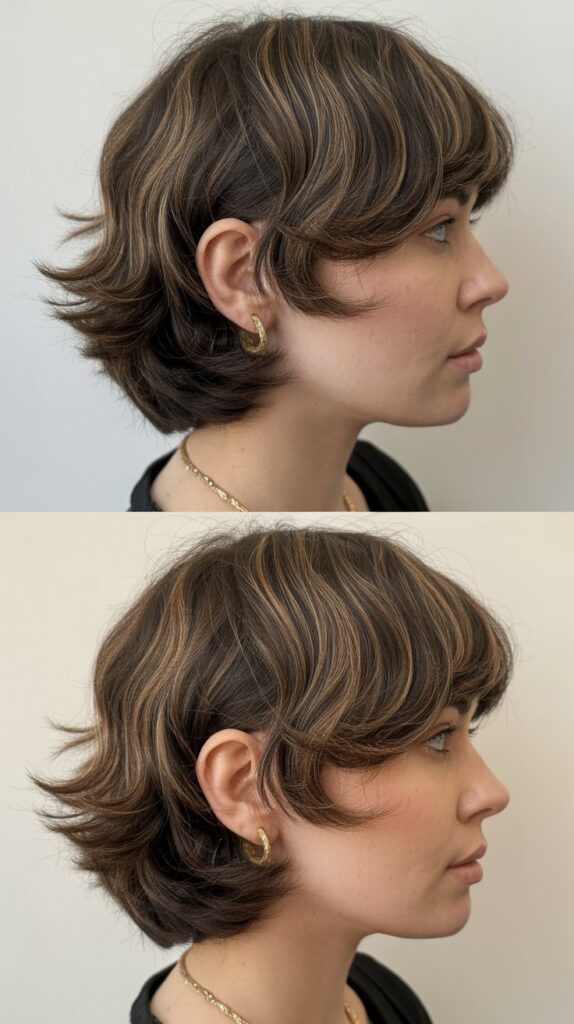
Cool-toned lowlight correction fixes unwanted warmth or brassiness in previously colored brown hair. This corrective technique uses ash or cool brown lowlights to neutralize orange or red tones.
- Color correction addresses previous color mishaps or natural brassiness that develops over time.
- Cool-toned lowlights deposit blue or violet pigments that neutralize unwanted warmth effectively.
- This technique requires consultation to assess existing color and determine appropriate correction shades.
- Application focuses on areas with most visible warmth, often around the face and surface layers.
- The correction process may require multiple sessions for severely brassy or damaged hair.
- Results create a neutral brown appearance that looks fresh and professionally maintained.
- Following up with purple-toning shampoos helps maintain the corrected cool tone between appointments.
- Corrective lowlights often cost more than standard applications due to the extra color expertise required.
22. Root Smudge with Lowlights
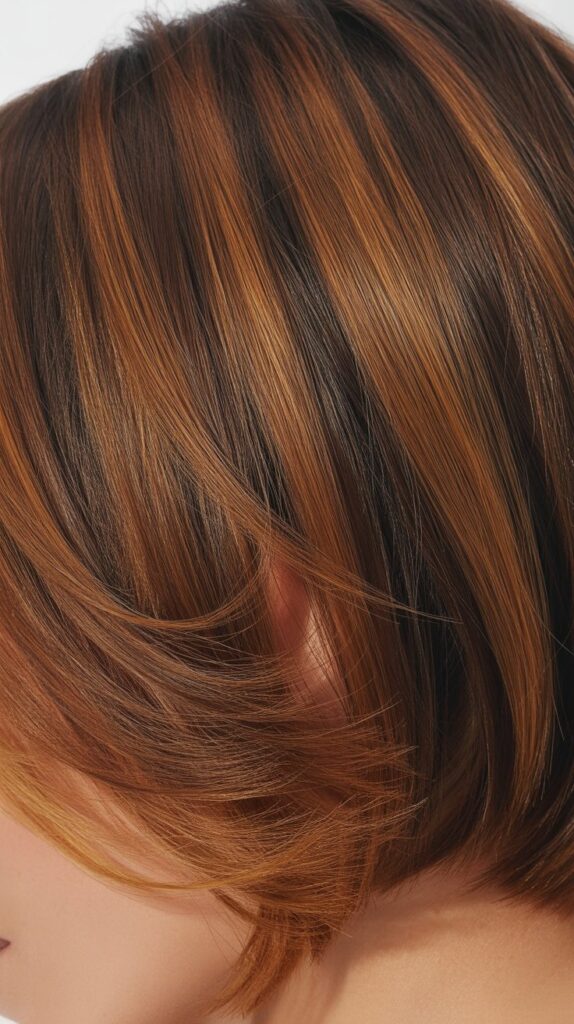
Root smudge combined with lowlights creates seamless color transitions from roots through ends. This technique blends newly grown natural roots with existing lowlights for a soft, graduated appearance.
- The smudging technique eliminates harsh lines where natural color meets lowlighted sections.
- This approach extends time between color appointments by making grow-out appear intentional.
- Application involves applying a transitional shade at the root area before processing lowlights.
- The blended roots create a natural shadow effect that adds depth and dimension.
- Root smudging works particularly well for short hair since the transition happens in a compact space.
- This technique suits busy individuals wanting low-maintenance color that still looks polished.
- The seamless blend makes hair appear healthier by eliminating obvious regrowth lines.
- Combining root smudge with lowlights typically adds 15-20 minutes to total processing time.
23. Dimensional Lowlights for Fine Hair

Dimensional lowlights specifically placed for fine hair create the illusion of thickness and fullness. This strategic technique uses color placement psychology to make sparse hair appear more abundant.
- Darker lowlights create shadows that give the impression of depth and density in fine hair.
- Strategic placement focuses on areas where volume is most needed, typically crown and sides.
- The visual thickness created by color dimension compensates for actual hair density.
- This technique works significantly better than all-over color for fine-haired individuals seeking fullness.
- Application avoids the hairline where fine hair is most sparse, preventing further emphasis on thinness.
- The dimension makes each strand more visible and defined rather than blending into a flat mass.
- Combining lowlights with texturizing cuts maximizes the thickness illusion for fine hair.
- This approach offers a non-damaging alternative to volumizing treatments for creating fuller appearance.
24. Seasonal Transition Lowlights

Seasonal transition lowlights change with fashion trends and the time of year. This adaptive approach keeps color current by adjusting lowlight shades to match seasonal color palettes.
- Fall and winter lowlights typically feature warmer tones like chestnut, mahogany, and deep chocolate.
- Spring and summer applications lean toward cooler ashy browns and lighter mocha tones.
- Seasonal changes keep hair looking fashion-forward and on-trend throughout the year.
- This approach allows experimentation with different shades without permanent commitment.
- Color transitions happen gradually over multiple appointments rather than dramatic overnight changes.
- Seasonal lowlights complement seasonal wardrobes, creating cohesive personal style.
- The changing colors prevent boredom with the same look year-round.
- Many salons offer seasonal color consultations to recommend trending shades for each client.
25. Balayage-Style Lowlights

Balayage-style lowlights use hand-painting techniques for artistic, natural-looking dimension. This freehand method creates customized lowlight placement perfect for short hair’s unique shape.
- The hand-painting technique allows colorists to place lowlights exactly where each haircut needs dimension.
- Balayage creates softer, more graduated transitions compared to traditional foil methods.
- This artistic approach results in unique, customized color that differs on each client.
- The technique works particularly well with short hair’s varied lengths and layers.
- Application focuses on creating natural-looking shadows that enhance the hair’s movement and texture.
- Balayage lowlights grow out more gracefully than foiled applications, reducing maintenance frequency.
- The freehand method typically costs more due to the advanced skill and time required.
- Results appear sun-kissed and effortless rather than obviously salon-colored.
26. Contour Lowlights for Face Shape

Contour lowlights use darker color placement to visually reshape and flatter face shapes. This technique applies color theory to create shadows that enhance natural features.
- Darker placement along the sides of round faces creates the illusion of length and angles.
- Lowlights near the temples and jawline define and structure square or angular faces.
- Strategic darkness around the crown area balances and proportions long face shapes.
- This advanced technique requires colorist expertise in face shape analysis and color placement theory.
- The contouring effect works similarly to makeup contouring but lasts significantly longer.
- Placement remains subtle enough to appear natural while still creating the desired reshaping effect.
- This technique particularly benefits short hair where face shape appears more prominent.
- Contour lowlights combined with strategic highlights create maximum face-flattering dimension.
27. Multi-Tonal Lowlight Blend

Multi-tonal lowlight blends combine three or more lowlight shades for complex, luxurious dimension. This premium technique creates the richest possible color depth for brown hair.
- Multiple shade variations provide unmatched visual interest and complexity in short hair.
- The combination typically includes one warm-toned, one cool-toned, and one neutral brown shade.
- This comprehensive approach suits those wanting maximum impact from their color investment.
- Application requires advanced color formulation skills and extended processing time.
- The varied tones create dimension that appears different in various lighting conditions.
- Multi-tonal blends work beautifully for special events or those wanting red-carpet-worthy color.
- The complex color ages gracefully, revealing different tones as some fade faster than others.
- This technique represents the pinnacle of lowlight artistry and typically comes with premium pricing.
Maintenance Tips for Lowlights on Short Brown Hair
Proper maintenance extends the life and vibrancy of your lowlights while keeping hair healthy. Short hair requires specific care routines that differ from longer lengths.
Essential Maintenance Table
- Invest in professional color-safe shampoo and conditioner formulated for brunettes.
- Wash hair in lukewarm water rather than hot to prevent color molecules from opening and escaping.
- Apply leave-in treatments specifically designed for color-treated hair after every wash.
- Minimize heat styling frequency and always use heat protectant products when styling.
- Consider installing a shower filter to remove mineral deposits that can alter lowlight tones.
- Schedule regular glossing treatments between lowlight appointments to maintain vibrancy and shine.
- Protect hair from sun exposure with UV-protectant sprays or hats during extended outdoor activities.
- Communicate with your stylist about any color changes or fading between appointments for adjustments.
For more information on maintaining colored hair, visit American Academy of Dermatology for professional hair care guidance.
Choosing the Right Lowlight Shade
Selecting the perfect lowlight shade depends on multiple factors including skin tone, natural base color, and desired maintenance level. Understanding these elements ensures satisfying, flattering results.
- Determine your skin’s undertone by examining veins on your inner wrist—blue veins indicate cool undertones while green veins suggest warm undertones.
- Cool skin tones pair beautifully with ash brown, espresso, and smoky lowlight shades.
- Warm skin tones shine with chocolate, mahogany, caramel, and chestnut lowlight options.
- Neutral skin tones have the most flexibility and can wear virtually any lowlight shade successfully.
- Consider your natural hair color as the starting point—lowlights should be one to three shades darker.
- Lifestyle and maintenance commitment should influence shade choice, with subtle options requiring less upkeep.
- Professional consultation helps identify the most flattering shades for your unique coloring and features.
- Bring inspiration photos to appointments but remain open to colorist recommendations based on your hair’s condition.
Professional vs. At-Home Lowlights
The decision between professional salon lowlights and at-home application significantly impacts results, especially with short hair where mistakes show prominently.
Comparison Table
- Professional colorists assess hair condition, porosity, and history before selecting appropriate lowlight formulas and techniques.
- At-home kits lack customization options and may not develop properly on previously colored hair.
- Short hair shows color mistakes more prominently than longer hair where errors can be hidden or cut away.
- Professional application ensures even saturation and proper placement for dimensional, flattering results.
- Salon-quality products contain conditioning agents that minimize damage during the coloring process.
- At-home application on short hair proves challenging due to limited working space and visibility issues.
- Professional colorists can blend multiple shades for complex, multi-tonal dimension impossible with single-shade kits.
- The investment in professional services often proves more cost-effective when considering potential correction expenses.
For expert hair coloring advice, consult resources at Good Housekeeping Beauty for product reviews and professional recommendations.
Styling Tips to Showcase Your Lowlights
Proper styling techniques maximize the visibility and impact of your lowlights, ensuring your color investment shows beautifully.
- Create texture through styling to allow lowlights to peek through and create dimensional movement.
- Use volumizing products at the roots to lift hair away from the scalp, revealing underneath lowlights.
- Side parts showcase face-framing lowlights more effectively than center parts on short hair.
- Tousled, textured styles display color dimension better than sleek, flat styling.
- Experiment with different styling directions to reveal hidden peekaboo lowlights in various ways.
- Apply lightweight hair oils to ends for shine that enhances color reflectivity and depth.
- Consider slight waves or curls that catch light differently and show off dimensional color placement.
- Avoid excessive product buildup that can dull color and hide carefully placed lowlight dimension.
- Photograph your hair in natural lighting where lowlights show most authentically and beautifully.
- Style hair away from your face occasionally to showcase any face-framing lowlight placement.
- Use round brush blow-drying techniques to create volume that separates strands and reveals color depth.
- Finish styles with light-hold hairspray rather than heavy products that weigh down dimensional color.
Common Lowlight Mistakes to Avoid
Understanding common pitfalls helps you avoid disappointing results and ensures successful lowlight application on short brown hair.
- Choosing lowlights too close to your natural shade wastes time and money with barely visible results.
- Selecting shades too dark creates harsh contrast that appears unnatural and grows out obviously.
- Placing lowlights only on surface layers misses opportunities for depth and dimension throughout the style.
- Over-processing hair with lowlights too frequently causes cumulative damage and color buildup.
- Mixing incompatible undertones creates muddy, unflattering color rather than clear, beautiful dimension.
- Skipping strand tests before full application risks unexpected color results or adverse reactions.
- Using regular shampoo instead of color-safe formulas strips lowlights prematurely, wasting your investment.
- Attempting complex techniques like balayage or multi-tonal blends without professional expertise often disappoints.
- Ignoring hair’s porosity and condition leads to uneven color absorption and patchy results.
- Failing to communicate clearly with your stylist about desired intensity and placement causes mismatched expectations.
- Neglecting proper maintenance routines accelerates fading and reduces the longevity of lowlight results.
- Applying lowlights over damaged or compromised hair exacerbates existing problems and creates poor color uptake.
Lowlights for Different Short Haircut Styles
Different short haircuts benefit from specific lowlight placement strategies that enhance each style’s unique characteristics.
Pixie Cuts
- Concentrate lowlights on longer top sections where dimension shows most prominently.
- Add face-framing lowlights around ears and temples to create softness and definition.
- Use ribbon lowlights through the crown area to emphasize the pixie’s textured styling.
- Keep lowlights minimal on very short sides and back where color barely shows.
Bob Haircuts
- Apply lowlights throughout all layers for comprehensive dimension on this classic cut.
- Focus darker shades underneath to create depth and the illusion of thickness.
- Add face-framing lowlights that follow the bob’s angle for enhanced structure.
- Consider reverse ombré lowlights that darken toward the perimeter for added weight.
Lob (Long Bob) Styles
- Utilize balayage-style lowlights that follow the hair’s natural movement and flow.
- Create multi-tonal blends throughout the length for maximum visual interest.
- Place strategic lowlights that enhance any waves or texture in the lob styling.
- Add dimensional ribbons that become visible when hair is tucked behind ears.
Asymmetrical Cuts
- Use lowlights to emphasize the dramatic angles and geometric lines of asymmetrical styles.
- Place contrasting lowlights on the longer side to draw attention to the asymmetry.
- Add peekaboo lowlights underneath that reveal when hair swings forward.
- Consider bold ribbon lowlights that follow and accentuate the cut’s unique shape.
Shag Haircuts
- Apply babylights and lowlights throughout all choppy layers for enhanced texture appearance.
- Use multiple lowlight shades to complement the shag’s inherently dimensional structure.
- Focus lowlights through the interior layers where the shag’s texture shows most.
- Add face-framing lowlights that work with the shag’s typically feathered front sections.
Cost Considerations for Lowlights
Understanding the financial investment required for quality lowlights helps with budgeting and planning your color maintenance.
- Basic single-process lowlights at mid-range salons typically cost between $80-$150 for short hair.
- Advanced techniques like balayage, multi-tonal blends, or tortoiseshell cost $150-$250 or more.
- Geographic location significantly impacts pricing, with urban salons charging premium rates.
- Stylist experience level affects cost—senior colorists and specialists charge more than junior stylists.
- Additional services like glossing treatments, deep conditioning, or styling add $20-$75 to base prices.
- Short hair requires less product than longer hair, sometimes resulting in modest price reductions.
- Maintenance appointments every 8-12 weeks create ongoing costs to factor into annual beauty budgets.
- Color correction for unsatisfactory results or previous mistakes costs significantly more than initial applications.
- Premium salon products and specialty techniques justify higher prices through superior results and longevity.
- Tipping your colorist typically adds 15-20% to the total service cost.
- Package deals or loyalty programs at salons may offer cost savings for regular color clients.
- At-home maintenance products (color-safe shampoo, conditioner, treatments) add $30-$100 monthly to color upkeep.
Lowlights for Different Age Groups
Lowlight strategies vary across age groups, with different priorities and considerations for teens, adults, and mature clients.
Teens and Young Adults (13-25)
- Experiment with trendy techniques like tortoiseshell or multi-tonal blends without commitment concerns.
- Focus on fun, dimensional looks that complement youthful energy and fashion-forward styles.
- Start with subtle lowlights to introduce color without dramatic changes or parental concerns.
- Consider peekaboo lowlights that offer versatility between school and social settings.
Adults (25-45)
- Prioritize professional-looking dimension that suits workplace environments and career advancement.
- Choose low-maintenance options that fit busy lifestyles with limited time for frequent salon visits.
- Select flattering shades that enhance skin tone and complement personal style evolution.
- Invest in quality applications and maintenance that deliver long-lasting, polished results.
Mature Clients (45+)
- Use strategic lowlights to add depth that counteracts the flattening effect of graying hair.
- Select rich, warm tones that brighten complexions and soften mature features.
- Combine lowlights with gray coverage techniques for comprehensive color solutions.
- Focus on sophisticated, timeless dimension rather than trendy or dramatic color choices.
- Consider lowlights as part of anti-aging beauty strategies that refresh overall appearance.
- Choose gentle formulas that respect potentially more delicate or fragile hair textures.
Combining Lowlights with Other Color Techniques
Lowlights often work best when combined with complementary color techniques for maximum dimensional impact.
- Lowlights + Highlights: Creates the most dimension by including both lighter and darker shades throughout hair.
- Lowlights + Balayage: Combines hand-painted lowlights with freehand highlights for artistic, natural results.
- Lowlights + Root Smudge: Ensures seamless color transitions from roots through ends for low-maintenance beauty.
- Lowlights + Glossing: Adds shine and vibrancy while sealing in lowlight color for extended longevity.
- Lowlights + Gray Coverage: Addresses gray hair while simultaneously adding depth and dimension throughout.
- Lowlights + Toning: Adjusts overall color temperature while maintaining dimensional lowlight placement.
- Lowlights + Color Correction: Fixes previous color mistakes while adding intentional depth to the new color.
The combination approach typically requires extended appointment times and higher costs but delivers superior results.
- Discuss multiple-technique combinations during consultations to ensure realistic time and cost expectations.
- Allow experienced colorists to recommend appropriate technique combinations for your specific hair goals.
- Schedule longer appointments when combining multiple color services to avoid rushed or incomplete results.
- Understand that combination services require greater color expertise and may necessitate specialist-level stylists.
Seasonal Care for Lowlighted Hair
Different seasons present unique challenges for maintaining beautiful lowlights on short brown hair throughout the year.
Summer Care
- Apply UV-protectant sprays before sun exposure to prevent color fading and brassiness.
- Rinse hair immediately after swimming to remove chlorine and salt that strip color.
- Wear hats or scarves during extended outdoor activities to shield hair from damaging sun rays.
- Increase deep conditioning frequency to combat dryness from heat, sun, and water exposure.
Fall Care
- Refresh lowlights as summer sun exposure may have caused fading or color shifts.
- Consider transitioning to warmer lowlight tones that complement autumn’s rich color palette.
- Address any summer damage with protein treatments before applying new color.
- Adjust styling routines as humidity decreases and hair behavior changes with temperature drops.
Winter Care
- Combat static and dryness with leave-in conditioners and anti-frizz products that won’t dull color.
- Protect hair from harsh winter winds and cold temperatures that can cause brittleness and breakage.
- Maintain moisture balance with weekly deep conditioning treatments during heating season.
- Be cautious of indoor heating that can dry hair and accelerate color fading.
Spring Care
- Schedule refresh appointments to revitalize lowlights after winter’s indoor heating exposure.
- Consider lighter, cooler lowlight tones that align with spring’s fresh, bright aesthetic.
- Address any winter damage or dullness before adding new color for optimal results.
- Prepare hair for increased humidity with anti-frizz treatments that maintain color vibrancy.
Troubleshooting Common Lowlight Issues
Even professional lowlight applications occasionally present challenges that require troubleshooting and solutions.
Issue: Lowlights Appear Too Dark
- Wait 1-2 weeks as color often lightens slightly after several washes.
- Use clarifying shampoo once to remove some color intensity if drastically too dark.
- Schedule a color correction appointment where highlights can be added to balance darkness.
- Avoid attempting to lighten at home as this risks further damage and uneven results.
Issue: Lowlights Faded Too Quickly
- Switch to color-depositing shampoos and conditioners that refresh color with each wash.
- Reduce washing frequency to every 2-3 days rather than daily washing.
- Avoid hot water which opens hair cuticles and releases color molecules.
- Schedule glossing treatments between full lowlight appointments to maintain vibrancy.
Issue: Uneven Color Results
- Contact your stylist immediately as reputable salons offer correction services for unsatisfactory results.
- Avoid washing hair for 48-72 hours after application to allow color to fully develop and settle.
- Understand that some unevenness normalizes after the first week as color oxidizes and settles.
- Request a complimentary correction appointment rather than attempting fixes at home.
Issue: Lowlights Turned Brassy or Orange
- Use purple or blue-toning shampoos designed for brunettes to neutralize unwanted warmth.
- Schedule a toning service that deposits cool pigments to counteract brass.
- Avoid heat styling without protectants as heat exposure accelerates brassiness development.
- Consider that brass may indicate underlying damage requiring treatment before further coloring.
Issue: Scalp Irritation After Application
- Apply cool compresses to soothe irritation and reduce inflammation.
- Use gentle, fragrance-free shampoos until irritation completely resolves.
- Contact your stylist about potential allergic reactions or sensitivity to specific color ingredients.
- Discontinue use of any new products introduced around the time of color application.
- Consult a dermatologist if irritation persists beyond a few days or worsens over time.
For additional hair care troubleshooting, visit WebMD Hair Health for medical perspectives on common hair issues.
Consultation Tips for Best Results
A thorough consultation with your colorist ensures aligned expectations and optimal lowlight results for your short brown hair.
- Bring multiple inspiration photos showing lowlights from different angles and lighting conditions.
- Discuss your complete color history including any previous coloring, treatments, or chemical services.
- Be honest about your maintenance commitment level and realistic appointment frequency expectations.
- Ask about your colorist’s experience specifically with lowlights on short hair styles.
- Request a strand test if trying a dramatically different shade or if hair has been heavily processed.
- Discuss your daily styling routine so the colorist can recommend lowlights that suit your lifestyle.
- Communicate any concerns about damage, breakage, or hair health issues affecting color decisions.
- Ask about the specific products and techniques the colorist plans to use for your lowlights.
- Establish clear pricing expectations including base service cost and any additional fees.
- Schedule adequate time for the appointment to avoid rushed or incomplete color application.
- Discuss aftercare requirements, maintenance products, and recommended follow-up appointment timing.
- Request the specific color formulas used so future appointments can replicate successful results.
- Address any previous disappointing color experiences to avoid repeating similar issues.
- Ask about the salon’s correction policy if you’re unsatisfied with the final results.
Hair Health Considerations
Maintaining healthy hair remains essential when adding lowlights, as compromised hair produces poor color results and uneven absorption.
- Schedule a trim to remove damaged ends before applying lowlights for better color uptake.
- Undergo deep conditioning treatments for 2-4 weeks before color if hair shows dryness or damage.
- Avoid lowlights if hair has been recently chemically straightened, permed, or heavily bleached.
- Consider protein treatments to strengthen hair structure before color application.
- Discuss porosity concerns with your colorist as highly porous hair absorbs color unevenly.
- Space out chemical services by at least 2-3 weeks to minimize cumulative damage.
- Use bond-building treatments during and after coloring to maintain hair integrity.
- Recognize that healthy hair holds color longer and looks more vibrant than damaged hair.
- Address scalp health issues like dandruff or excessive oiliness before color appointments.
- Consider your hair’s natural texture and how color processing might affect curl pattern or texture.
- Evaluate whether hair extensions or previous extension application affects color planning.
- Understand that over-processed hair may require extra time between color applications to recover.
Environmental and Lifestyle Factors
Your environment and daily activities significantly impact how lowlights appear and how long they last on short brown hair.
Water Quality Impact
- Hard water with high mineral content can cause color shifts and brassiness in lowlights.
- Install shower filters to remove minerals that alter hair color and cause buildup.
- Chelating treatments remove mineral deposits that interfere with color vibrancy.
- Well water often contains iron that can turn brown lowlights orange or red.
Activity Level Considerations
- Frequent swimmers need lowlights with extra staying power and protective pre-swim treatments.
- Athletes who wash hair daily require low-maintenance lowlight options that withstand frequent washing.
- Outdoor workers need UV protection and possibly darker lowlights that hide sun-fading better.
- Gym-goers should use dry shampoo between washes to extend color life while managing sweat.
Climate Effects
- Humid climates may cause frizz that requires smoothing products compatible with color-treated hair.
- Dry climates necessitate extra moisture treatments to prevent color from appearing dull or brittle.
- Sunny locations require diligent UV protection to prevent premature fading and color shifts.
- Extreme temperature fluctuations require adaptable care routines that protect color year-round.
Professional Requirements
- Conservative workplaces may restrict color choices to subtle, natural-looking lowlight options.
- Creative industries often welcome bolder lowlight techniques and experimental color combinations.
- Client-facing positions benefit from polished, well-maintained lowlights that appear professional.
- Uniform requirements or specific dress codes may influence appropriate lowlight intensity and placement.
Future Color Planning
Strategic lowlight application considers not just current desires but future color goals and possibilities.
- Choose lowlight shades that provide flexibility for future color changes or adjustments.
- Avoid extremely dark lowlights if you plan to go lighter eventually, as removal proves difficult.
- Build gradually toward dramatic color goals rather than attempting drastic changes immediately.
- Maintain some natural hair for comparison and easier color corrections if needed.
- Document successful color formulas and placements for consistent results across appointments.
- Discuss long-term color goals during consultations so colorists can plan progressive steps.
- Consider how planned haircut changes might affect lowlight visibility and placement strategy.
- Plan color appointments around major life events where you want hair looking its absolute best.
- Budget for both regular maintenance and occasional refresh services that keep color exciting.
- Remain flexible as hair needs change with age, lifestyle shifts, or personal style evolution.
- Build relationships with trusted colorists who understand your hair history and future aspirations.
- Keep inspiration collections updated with new lowlight ideas that appeal to evolving preferences.
Conclusion
Exploring 27+ trendy lowlights for short brown hair on brunettes opens up a world of dimensional possibilities that transform your look from ordinary to extraordinary.
Whether you choose classic chocolate depth, adventurous burgundy tints, or sophisticated multi-tonal blends, the right lowlights enhance your natural beauty while expressing your personal style.
Short hair provides the perfect canvas for showcasing carefully placed lowlights, as every strand remains visible and contributes to the overall dimensional effect.
The key to success lies in selecting shades that complement your skin tone, match your maintenance commitment level, and work harmoniously with your haircut’s unique shape and structure.
Professional application ensures precision placement that flatters your features while maintaining hair health throughout the coloring process.
With proper maintenance routines, quality products, and regular salon visits, your lowlights will continue looking fresh and vibrant for weeks between appointments.
Remember that lowlights offer remarkable versatility—they can be subtle enough for conservative environments or bold enough to make definitive style statements.
The trending techniques presented in this guide for 27+ trendy lowlights for short brown hair on brunettes provide endless inspiration for your next salon visit, ensuring you find the perfect dimensional color that makes you feel confident and beautiful every single day.
